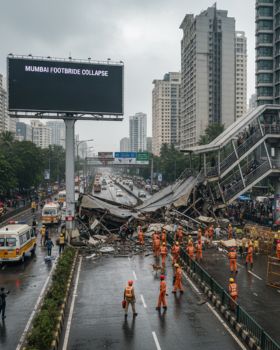
Disclaimer:
This blog is intended for informational and educational purposes only. It is based on publicly available reports and expert analyses of the Sampoong Department Store collapse. The content does not assign blame or liability to any individual or organization. Instead, it aims to highlight the importance of safety, compliance, and risk management in construction and contractor operations. All efforts have been made to present the facts neutrally and respectfully.
On June 29, 1995, the world witnessed one of the deadliest structural failures in modern history—the Sampoong Collapse in Seoul, South Korea. This tragic event, which unfolded in a matter of seconds, claimed over 500 lives and injured more than 1,000 people. Today, the Sampoong incident stands as a stark reminder of the critical importance of construction safety, regulatory oversight, and early risk detection.
This blog revisits the Sampoong disaster to understand the sequence of events, identify key contributing factors, and highlight important lessons in safety and compliance that continue to guide professionals in construction, engineering, and contractor management worldwide.
Understanding the Background of the Sampoong Mall Collapse
The Sampoong Building Collapse occurred at a luxury department store located in the Seocho District of Seoul. The building, known as the Sampoong Mall, was a popular shopping destination with hundreds of daily visitors. Originally intended as a four-story residential building, the design was later changed to accommodate five commercial floors, including a rooftop restaurant. These design alterations, though seemingly minor at the time, introduced a number of structural vulnerabilities.
Key Factors That Contributed to the Collapse
The Sampoong disaster was not the result of a single failure but rather a series of compounding issues. While the official investigations cited engineering miscalculations and construction flaws, modern safety experts point to several broader systemic factors:
- Design Modifications
The decision to add a fifth floor and change the use from residential to commercial placed additional loads on the building. These changes reportedly did not include corresponding reinforcement of the foundational and structural components. This created a condition where the building was supporting more weight than it was originally designed to handle.
- Structural Overload
The rooftop restaurant on the fifth floor used heavy commercial-grade air conditioning units. These units were later moved across the roof using rollers, which may have weakened the structure further. The positioning of such heavy equipment directly above structural columns created stress concentrations that were not accounted for in the original design.
- Column Failure
One of the critical technical causes was the failure of a central column. Photographs and retrospective reports suggest cracks may have been visible in a column prior to the collapse. It remains unclear whether these signs were fully understood or acted upon in time. This highlights the importance of routine inspection, early warning systems, and prompt response to visible structural warning signs.
- Material and Construction Quality
Some retrospective analyses raised concerns about whether budget constraints during construction may have affected material choices. These factors, while unconfirmed, are often explored in post-incident safety evaluations. In high-risk infrastructure, even small compromises in material quality can significantly increase the risk of failure over time.
Timeline of the Collapse
The collapse occurred in the early evening when the building was at its busiest. In the days leading up to the incident, shoppers and staff reportedly noticed unusual sounds and visible cracks forming in the ceiling. By the afternoon of June 29, the upper floor began sagging, and minutes before the building fell, a loud cracking noise was heard.
Despite visible warning signs, evacuation was reportedly delayed. The timeline of actions taken remains a significant point of discussion in post-event analyses. The building collapsed rapidly, trapping hundreds of people beneath the debris. Emergency responders arrived quickly and worked for days in difficult conditions to rescue survivors and recover victims.
Lessons Learned from the Sampoong Incident
While the Sampoong Mall Collapse was a deeply tragic event, it also served as a case study in how safety culture, oversight, and preventive actions can make a difference. Several key takeaways continue to inform best practices across industries today:
- Early Warning Signals Should Not Be Ignored
Even small cracks, sounds, or changes in structure should trigger an immediate investigation. When in doubt, evacuation and safety checks are better than delayed action.
- Design Changes Must Be Rigorously Reviewed
Any modification to a structure—whether during planning or post-construction—should be reviewed by qualified engineers. These changes should comply with updated structural models and safety codes.
- Accountability Through Compliance
Today’s construction industry is governed by stricter safety codes and compliance requirements. However, the human and systemic factors—communication gaps, shortcuts, or delayed reporting—still require active monitoring and management.
- Technology Can Support Risk Awareness
Modern technologies—such as building information modeling (BIM), safety management software, and contractor compliance tools—can help identify and address risks in real-time. These tools could have helped reduce the likelihood or severity of such failures by making risk factors more visible and traceable.
Why This Disaster Still Matters
The Sampoong Building Collapse remains one of the most frequently cited examples in engineering textbooks and risk management seminars. It illustrates that disasters rarely happen out of the blue—they usually result from a cascade of smaller, overlooked issues that go unaddressed.
It is not only an engineering or construction concern but a human one. People’s lives depend on the decisions made long before a structure opens its doors.
A Path Toward Safer Worksites
As organizations continue to evolve their safety practices, one thing remains clear—proactive planning, transparent compliance, and clear communication can go a long way in avoiding repeat tragedies. While it is impossible to predict every hazard, we can reduce the likelihood and impact through layered safety systems, reliable technology, and a culture that encourages early reporting and learning from near misses.
Conclusion: Using the Past to Build a Safer Future
The Sampoong incident is more than just a tragic chapter in South Korea’s history—it’s a reminder of what can go wrong when safety is not prioritized at every step. By understanding the contributing factors of the Sampoong disaster, industries can adopt safer design practices, enforce stronger oversight, and implement better contractor and construction monitoring systems.
Solutions such as Contractor Management Software and Work Permit Systems are tools that—when used wisely—could help in identifying risks early and maintaining accountability across all project phases. They’re not just compliance enablers but potential life-saving resources.
Let the memory of the Sampoong collapse not only honor the lives lost but also inspire better standards, safer workplaces, and more resilient infrastructure in the years to come.
🚀 Start a trial today and see how our platform can support your safety goals!
📧 info@sheqnetwork.com | 📞 +353 21 4536034
🔗 Learn more at sheqnetwork.com
📅 Ready for a personalized demo? Book your session here
Let’s build a safer future — together.




One Comment